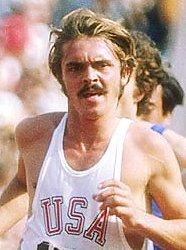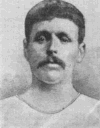I love music. I love music far more than running, truth be told, which, in summers like this one, isn't hard. And, I am big on wanting to block things out in certain situations - in grad school, I took almost all my exams with headphones on, back in the days when even recordable CD's were not commonplace. The one time I was asked to remove the headphones, I was lost, and couldn't focus. Having not gone to that class at all may have also figured into the negative experience, but I really felt I was better off writing about immigration law with Tanya Donnelly's sweet voice in my head.
In 2007, USA Track and Field made personal music devices
verboten at sanctioned events. The Austin Marathon and Half Marathon, as required, banned headphone use in 2008. Prior to that, lacking an enforcement mechanism, the marathon went with just strongly discouraging their use.
Many large marathons, including the Marine Corps Marathon, immediately, and probably eagerly, complied. The Twin Cities Marathon warned people headphones were banned, but people ignored the warnings, or perhaps couldn't hear them over the Justin Timberlake rattling in their skulls, and 176 runners were disqualified. It was not enforced in Austin, and headphone use in races is increasing exponentially.
The flap from the average headphone-wearing runner crowd pushed the USATF to reconsider, and within a year, they backed off, largely due to the incessant whinging (not a typo, Cindy) from people who want to say they can run a half marathon or marathon, but claim they can't do it without their headphones.
Shortly thereafter, the Austin Marathon reluctantly announced that it changed its headphone policy in accordance with the caving of the USATF, even though they've seen, time and time again, in every race, the high frequency of irresponsible headphone use and the problems it causes, but they probably just got tired of the complaints from people who probably went on to organize and be the loudest people at Tea Parties. The amount of whining they'd gotten at the marathon office about the headphone ban has quite frankly been pathetic, and has included ridiculous arguments about blind or deaf runners, claims about "big government", and many people saying they are disgusted and will just run some other race, to which I personally say, "good riddance, break a leg."
In large part, the USATF enacted the rule to conform to the policy of the International Association of Athletics Federations, which is mainly concerned with the use of two-way radios in competition.
For most races, though, the main issue is safety. I can't think of the last race where I didn't see a number of examples of people being completely oblivious to their surroundings because they were wearing headphones. I've seen people not able to hear the sirens of support vehicles passing them, a half marathoner in Dallas not able to hear the large, honking Hummer pace vehicle behind her or the runners around her yelling at her to move so the elite marathoners could pass, or the shouts of "wheelchair up" when a wheelchair racer needs to be able to pass. We've all seen that when moving through a not-too-thick crowd, a runner will usually hear you come up and often move over just a little to help you pass through a tight spot. Runners with headphones tend to be in their own little world, though.
One year, at the Turkey Trot, Michelle from Conley Sports (the folks who put on the Austin Marathon) was blowing past me just as I was trying to say hi to someone I knew. He was wearing headphones. I called his name from about 20 feet away. Nothing. I got closer, at one point just about five feet behind him, and yelled his name. Nothing.
This year, at the Zooma Half Marathon, we had a major problem with the turnaround. I hopped on the back of the course manager's Harley (please... don't picture it, we had no choice), and he took me down to the turnaround point. On the way, I shouted instructions, mainly to blank stares from the runners, almost half of which seemed to be wearing headphones. One woman was running up a hill with her head down (a problem in and of itself), and couldn't hear the large hog approaching her, or the yelling from us or the other runners, until she almost ran right into us.
I also believe (pause for effect) that headphones have a deleterious effect on running form. Yeah, that's right. I'm tempted to submit an article on "iPod Assymetry Syndrome" and submit it to a medical journal, except that I'm lazy.
I first started thinking about this while watching an avid marathoner I know that would wear her iPod on her right arm. She also wore her long hair in a ponytail, and many times, running behind her, I could see the ponytail didn't swing evenly. You could trace the asymmetry to her shoulders, and to... the arm with the iPod strapped to it. From there, you could even see the slight imbalance in her stride. She even had some issues in the leg that ended up getting the shortened stride, which could be due to any number of factors... but you had to wonder.
I know when I run with an iPod on my arm, it's easy to get caught up in cord management (pardon the pun). Watch runners, and most of them carry their music-bearing arm differently. I've already seen some of you compromising your running form to accomodate your headphones.
As we've all figured out by now, the high repetition of the motions of running means that imbalances and eccentricities have consequences, and will likely be mirrored elsewhere. Everyone should, by now, be feeling and seeing the link between the way you move your arms, and your stride.
When you shorten the travel of one arm, it's likely to play out in the stride, because you're essentially throwing yourself out of balance. There's also the added tension in the shoulder from carrying that arm out slightly. Over any appreciable distance, it all translates to "no bueno."
When I do take the iPod on a training run, I use a little Shuffle and attach it to my waistband - it doesn't move through a range of motion, so the cord stays stable. Even then, I make the the cord short enough or run it through my shirt so that I don't have to move the arm on that side any differently to clear it.
Finally, and most importantly to me, I don't want to race or even train much with music, because it's a crutch, even a cheat. Clearly, we want to run with music because it benefits us - it keeps us from getting bored, it motivates us. There's a reason the Nike+ iPod system has a "Power Song" feature. Hell, I want to add a Nano to my ridiculously complete Apple audio product lineup just so I can push the button and immediately go to AC/DC's "Hell's Bells".
One whin- sorry, "runner", in one article said, "I need my music to get me through it. A marathon is a mental challenge and if I don't have my music to keep me motivated, it just isn't fun."
Well, guess what? Remember that we do this precisely because it is not "easy", and it is not "fun" in the same way as, say, Whack-A-Mole, or taunting Aggies. You've all learned or will learn how important the mental component of distance running is. The thing is, we're not all running to challenge the winning time in a race - we all run to challenge our own limits and abilities, and that's ultimately a mental challenge of your ability to deal with discomfort and pain, and to continue to push yourself. Whether you are physically capable of running a 2:20, three-hour, four-hour, or five-plus hour marathon, it all comes down to your ability to push yourself, not just physically, but primarily mentally.
If you say you get bored, or need the distraction, and music helps you, then that music is a crutch. The mind is a powerful thing - I completely believe I could run a faster race at almost any distance with the "Rocky" theme pounding through my head every step of the way. I'll do some of my short runs with music, but I don't wear headphones for long runs or races, exactly because music is such an effective crutch.
That state of being alone in your head, is one of the difficult, but essential, parts of distance running. The challenge is not just to move your body over the distance, but to move your mind and your will over that distance. Can you keep your mental focus over the miles, and over the time you need to complete those miles? Music can help you dissociate, which is a perfectly acceptable method of dealing with pain and boredom. But again, it's external, it's not a skill or a layer of toughness you've developed. You're just taking it away. You might as well be racing on painkillers, or high. Numb your mind with headphones, and you have failed to accomplish an essential component of the challenge. If you can't live with your own mind for the distance you're running, then you can't really claim to do the distance.
Music is a crutch. It's a cheat. I want you to be able to depend on yourself to get through the race.
There are going to be helpful distractions out on the race course. We've got 40 bands on and around the marathon course, far more than the "Rock 'n' Roll" marathons in San Antonio and elsewhere. There'll be great crowd support, you'll have friends out there running with you, and, if you're not wearing headphones, you'll be surprised by how many people you'll talk to on the way. Every year, I see and chat with Steve Boone, this older guy with long, stringy grey hair. He's run every Austin Marathon, and runs over fifty marathons a year (in 2009, he ran Austin the day after running one in California). He doesn't run with headphones. But all those things are part of the race experience itself, not something extra and unnecessary you bring into the race to help you get through.
I'd hate to think of what I'd have missed wearing headphones in races:
the little kids in Chicago's Mexican district yelling, "Si, se puede!";
my friend Tom telling me about his kids, including the newborn son that didn't make it, as we plodded through 20 miles; or the company of good friends for
our first half marathon. Those were all hard races, and maybe headphones would have helped. But I wouldn't have the experiences and memories that made running those races meaningful.
Use your headphones on your solo runs, and let it help drive you. Let some music or podcasts, or whatever noise you need help you get those weekday runs in. Listen to some relaxing music the night before the race. Crank the tunes up in your car on the way to the race, and get pumped.
But don't use headphones in races. And, if you make that commitment, don't wear them for your long runs - that's where you're going to need to develop the mental toughness that will get you through your goal race.
In the end, it's about safety, and it's about not selling yourself short, not cheapening all the work you're putting in to this. Don't fail to truly meet the challenge you signed up for and are training for. Don't miss the very real support and inspiration that your teammates and the race itself is going to offer you. Leave the headphones at home.


